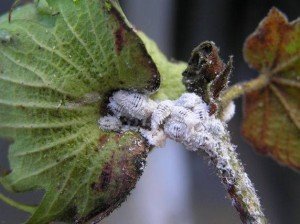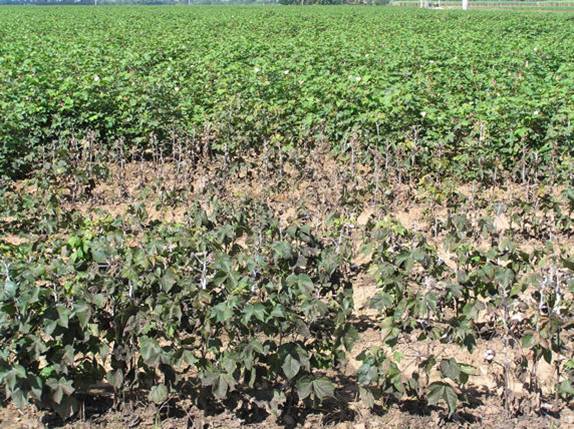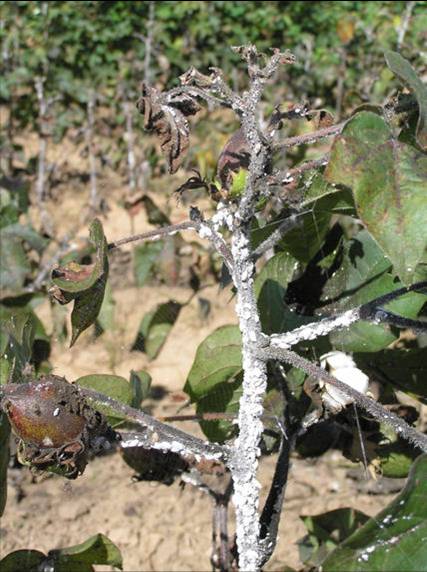Outbreaks of mealybugs have recently been reported from a number of cotton farms in central Queensland. While mealybugs are considered a minor pest of cotton, they have, on rare occasions, reached minor outbreak levels or ‘hotspots’ in commercial crops in central Queensland. Earlier this year mealybugs were reported causing some problems in Burdekin cotton. Reports from cotton growing areas in Pakistan and India over the last three years indicate that mealybugs have the potential to become a major pest.

Mealybugs are small, sucking insects related to aphids. Female adults are around 3 mm long, oval-shaped and covered by a white waxy coating giving them a mealy appearance. Nymphs are smaller but similar in appearance. Males are small aphid-like winged insects.
Mealybugs have a high reproduction rate with female mealybugs capable of producing hundreds of nymphs. Development from egg to adults takes about 26 days and adults can live for about three months.
Damage symptoms
Mealybugs form colonies on shoots, stems, and leaves developing into dense, waxy, white masses. Both adults and nymphs pierce and suck on plant tissue and are able to suck sap from hard tissue, including the main stem and branches. They can affect any stage of crop development.
Symptoms of mealybug infestations on cotton include; crinkled and twisted leaves, fewer flowers and fewer bolls, smaller bolls, and distorted and stunted plants. Boll opening may also be adversely affected, resulting in serious losses in yield.
Mealybugs, like aphids, excrete copious amounts of honeydew that contribute to the development of a black sooty mould which inhibits the plant’s ability to manufacture its food. Ants feed on the honeydew produced by mealybugs and help to spread the infestation. Ants also protect mealy bugs from predatory ladybird beetles, parasites and other natural enemies.
Where are they found?
Mealybugs are present in all cotton growing regions of the world. However on the Indian subcontinent, the exotic Phenacoccus solenopsis has become a major pest, possibly due to favourable weather conditions and an abundance of host plants. It has been responsible for heavy losses in Pakistan where it is now considered a major pest of cotton.
A mealybug found in Australian cotton fields in the Burdekin region was identified as Phenacoccus parvus. This pest was introduced accidentally as a contaminant on imported plants in 1988. P. parvus was initially found in isolated populations from far north Queensland to central New South Wales, and around Perth. It is more common in the drier regions of northern New South Wales and southern Queensland and population numbers of P. parvus increase during dry periods. Heavy infestations have been reported on lantana in south east Queensland. The species of mealybug infesting cotton in the Emerald region is yet to be determined.
Management of mealybugs
There are no registered insecticides for the control of mealybugs on cotton in Australia. In Pakistan numerous pesticides have been evaluated for the control this pest, but a hydrophobic (water repellant) layer around its body makes it difficult to control with insecticides. To achieve effective chemical control, an insecticide must penetrate the outer waxy layer.
The adult mealybug can shelter in the soil, cracks and other places where insecticide sprays cannot reach it.
The insect damage often appears in patches within a field, along field margins and poorly drained areas. Mealybugs have numerous weed and crop plants that they use as alternate hosts; cotton, lantana, leucaena and peanuts are just a few.
Control of weeds and ratoon cotton, and avoiding planting on poorly drained soil is the best management option for controlling mealybugs at present.
More information about the mealybug problem in India and Pakistan can be found on the CRDC website at www.crdc.com.au. To find the article search for mealybugs at the top of the page.
Other pests
We have received a few reports from other pests in various crops. These include; Rutherglen bugs in mungbeans, monolepta beetles on peanuts and legume web spinners on soybeans. Please let us know if you are finding these pests and we can feature an article on these, or others you find, in the next blog.
Article by Kate Charleston and David Murray. Images by Paul Grundy.



I am impressed with the idea of this blog though my search was for mealybugs as a possible biological control of Bryophylum. Is there a similar site for weed control trials and successes/failures? I live in Wee Waa so the idea of using mealybugs as a bio control here does not present as a good idea and that is useful data.